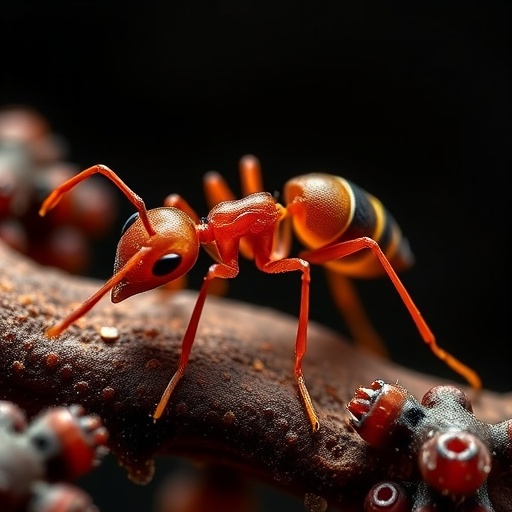In the realm of sensory biology, a foundational question revolves around how neurons achieve the remarkable specificity required for accurate signal detection. In olfaction, this specificity hinges on the stringent expression of a single olfactory receptor (Or) gene per sensory neuron, an evolutionary strategy that ensures that each neuron responds to a distinct set of chemical cues. This principle has been well documented in mammals, where olfactory sensory neurons select one receptor out of a potential thousand, enforcing a ‘one receptor, one neuron’ rule that underpins the fidelity of the olfactory system.
The mechanisms underlying this selection have been extensively studied in mammals. Here, the choice of a single Or gene is largely stochastic, orchestrated through complex regulatory networks involving enhancer elements, feedback loops, and chromatin dynamics. Such mechanisms effectively orchestrate a singular expression, despite the daunting numerical scale of potential receptor genes. In contrast, organisms like the vinegar fly Drosophila melanogaster harbor approximately 60 Or genes and employ deterministic rules for receptor gene selection, favoring a more predictable, pre-set pattern of expression.
Amidst these known systems, the ant species Harpegnathos saltator presents a compelling case study. Ants possess a vast repertoire of Or genes organized into tandem arrays akin to those found in mammals, but evolutionary pressures have seemingly sculpted a unique method of managing receptor gene choice. Recent groundbreaking research reveals that ants utilize a transcriptional-interference-based mechanism to assure singular receptor expression, a method distinct from the stochastic or deterministic paradigms classically described.
The research unveils that within the Or gene arrays of Harpegnathos saltator, a single promoter is actively engaged per neuron, initiating the transcription of a mature, capped, and polyadenylated mRNA corresponding to one receptor gene. Intriguingly, downstream promoters within the array generally remain inactive. However, transcription does not halt at the boundaries of the expressed gene; instead, RNA polymerase II inefficiently terminates transcription, resulting in transcriptional readthrough that extends into adjacent downstream genes.
This readthrough mechanism is pivotal. While downstream genes are transcribed due to the readthrough, the transcripts emerging from these genes are aberrant—lacking proper capping and polyadenylation—and are not translated into functional proteins. The consequence is an effective suppression of these downstream genes, accomplished via transcriptional interference. This interference likely represents a form of cis-regulation where the act of transcription through a downstream promoter region impedes its activation, thereby preventing multiple receptor genes from being functionally expressed in the same neuron.
Concurrently, another layer of regulation operates at the upstream end of the array. Here, extensive antisense transcription originates from the active receptor promoter, extending upstream to cover adjacent Or genes. This antisense transcription presumably exerts a silencing effect on these upstream genes, reinforcing the monoallelic expression of the receptor gene chosen by the neuron. Thus, antisense transcripts contribute to a spatially coherent regulatory landscape that confines receptor expression to a single locus.
Taken together, this finely tuned regulation ensures that only one receptor gene in the array is expressed at full maturity, encoding a functional olfactory receptor protein, while neighboring genes remain inert. These transcriptional interferences represent an elegant evolutionary innovation, tailoring receptor gene expression to neuronal specificity without relying on stochastic selection or preset deterministic cues observed in other species.
The study highlights the interplay between transcriptional readthrough, interference, and antisense transcription, painting a comprehensive picture of how transcriptional dynamics can mediate gene expression specificity. It underscores the adaptability of genome regulatory mechanisms across different evolutionary contexts and the potential for diverse molecular strategies to solve common biological challenges.
Such findings open avenues for deeper exploration into the molecular machinery governing transcriptional termination and interference. Understanding the factors that modulate RNA polymerase II processivity and termination efficiency could reveal further details about how transcriptional readthrough is controlled and harnessed for gene regulatory purposes.
Moreover, this work also invites reflection on the evolutionary pressures that might have shaped such a mechanism in ants. Given the ecological and social complexities of ant colonies, a robust system for olfactory discrimination is paramount. The transcriptional interference mechanism may offer a precise, energetically favorable solution for receptor gene regulation suited to the ant’s unique biological needs.
This ant-specific transcriptional regulation paradigm not only broadens our understanding of olfactory receptor gene control but may also inspire synthetic biology approaches where controlled gene expression from tandem arrays is desirable. Leveraging transcriptional interference could be a strategy for designing gene circuits with restricted gene expression profiles.
In broader terms, these insights enrich the tapestry of gene regulation strategies employed across life forms, highlighting that nature often arrives at multiple solutions for similar problems. Transcriptional interference in ants exemplifies how gene expression control can transcend traditional promoter-centric views, incorporating genome architecture and RNA processing intricacies into the regulatory logic.
As interest in sensory biology and gene regulation continues to crescendo, such discoveries underscore the need for integrative, multidisciplinary approaches. Combining genomics, transcriptomics, molecular biology, and computational modeling will be essential to deciphering the full complexity of receptor gene regulation in diverse organisms.
In conclusion, the ant Harpegnathos saltator exemplifies a novel evolutionary strategy to enforce the one receptor per neuron rule via complex transcriptional interference, a mechanism that simultaneously suppresses non-chosen receptor genes through readthrough and antisense transcription. This work not only advances our fundamental understanding of sensory neuron specificity but also uncovers new biological phenomena with broad implications in molecular genetics and evolutionary biology.
Subject of Research: Olfactory receptor gene regulation in the ant Harpegnathos saltator
Article Title: Transcriptional interferences ensure one olfactory receptor per ant neuron
Article References:
Sieriebriennikov, B., Kolumba, O., de Beaurepaire, A. et al. Transcriptional interferences ensure one olfactory receptor per ant neuron. Nature (2025). https://doi.org/10.1038/s41586-025-09664-x
Image Credits: AI Generated
Tags: ant olfactory receptor gene organizationchromatin dynamics in receptor expressionDrosophila olfactory receptor genesenhancer elements in olfactory genesevolutionary strategies in olfactory systemsHarpegnathos saltator olfactory biologyolfactory sensory neuron fidelityregulatory networks in gene selectionsensory neuron specificity mechanismssingle olfactory receptor expressionstochastic vs deterministic gene expressiontranscriptional interference in olfaction





